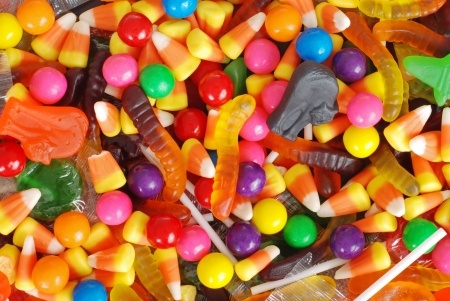Managing Halloween candy for our children is a simple way to prevent overindulging of artificial colors, dyes, chemicals and sugar found in many treats.
Halloween marks the beginning of sugar or flu season followed by Thanksgiving, Christmas, Valentine’s Day, and Easter! Since Halloween will soon be upon us, let’s start with it and hope these tips will keep your children healthier long-term yet still enjoy some treats.
Many believe flu season is caused by compromised digestive and immune systems created by this excess sugar intake along with lack of hydration and sunlight.
So let’s work on preventing colds, flu and disease naturally but limiting our sugar intake and especially for our children.
8 Tips for Managing Halloween Candy
1. Buy your candy a couple of days before Halloween. Halloween treats show up in the stores in late September. Don’t fall into the marketing trap and get tempted to buy candy early, that includes the grocery line where kids will get tempted with all sorts of Halloween promotions. Buying candy too early makes it way too tempting to get into the stash before trick-or-treating even starts.
2. Set expectations early. Prepare your child the day before Halloween. Talk about how much fun it will be to go trick-or-treating but not so much fun for their body if they eat a lot of candy. It is important for kids to learn that candy is a treat that should be eaten in small doses. They can spread their candy over many days, by dividing it up. Help your child see the benefit of making Halloween treats last longer.
3. Determine a reasonable number of days to enjoy the candy. Five days is a good goal. Most children will get way more candy than needed, even when they divide it up. You don’t want to teach your child to eat candy every day, since it is a once in a while treat.
4. Agree upon when the candy treat will be eaten. This helps your child learn that candy can be an occasional part of a healthy meal plan.
5. Discuss candy-eating rules with your child before they go out trick-or-treating. Children should not eat candy until they have come home and you have inspected all the candy. This is a good rule that is part of having a safe Halloween. Look at the wrapping carefully for a tight seal and toss out anything that looks suspicious.
6. It is best to feed your child first. Feed them dinner or a healthy snack such as a peanut butter sandwich and a piece of fresh fruit before going trick-or-treating. They will be less tempted to dig into their bag before they get home.
7. Have your child actively participate in dividing up their candy. Consider making little treat bags they can enjoy, one each day. This gets the child involved in the decision-making and helps them feel ownership of the process. Keep it fun! You can take advantage of the candy by playing games. For example, have your child count all of the chocolate bars or separate the candy into groups – all the M&M’s in one pile, all the Skittles in another, and so on.
Using mini-sized bags, help your child pick and choose a couple of pieces of their favorite candy to place in each baggie. This helps them learn portion control, a very important part of healthy eating.
Store the extra baggies of candy in a cabinet out of reach. Do not store the candy in their room to tempt them. Remember, they are children and make decisions accordingly. And my favorite trick is once they forget about the candy, that’s a good time to secretly dispose of it!
8. Candy Swap or Switch Witch
At the end of the night, many parents will swap out the entire bag of candy for money, toys or maybe a special experience the child has been wanting. Discussing this with the child in advance is a good way to avoid a surprise and creates open communication.
If you have tips and strategies that have worked for you, please share them with us in the comments section.





